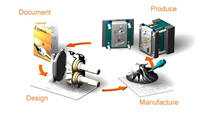Engineering Academy Required Courses
A total of four courses or five (computer engineering), an internship and one year of an after
school course are required for each Engineering Academy student.
There are eight engineering courses taught during the regular
school day, which are Introduction to Design (ID), Architectural Design 1-2 (AD), Honors Principles of Engineering (POE), Pre-Engineering and Design (PED), Civil Engineering and Architecture (CEA), Computer Integrated Manufacturing (CIM), AP Computer Science Principles (CSP), and
Engineering Design and
Development (EDD). There are two courses taught after school,
which are Science Olympiad and Robotics (which Robotics is a course and Science Olympiad a club).
Students are expected to be part of one of these after-school
programs for one year of high school in order to receive the
“Engineering Academy Certificate of
Completion” recognition.
In addition to the regular school day and after-school courses, students
are required to enroll in an Engineering Internship through PUSD
during their senior year.
Northrop Grumman, Palomar Technologies and other companies in Poway provide
opportunities for high school interns through PUSD.

Engineering Academy “Core” Course Descriptions
Below is a list of courses that are included in the Engineering
Academy “core”. These
courses can also be found in the Poway High School Course Catalog. Students choosing to enroll in courses as an exploration pathway can take courses in any order or amount. Students choosing to commit to the academy through the application process must take two Foundations courses (one design + one applied science), one specialization course, the capstone, an internship, plus one after school course for a year. The optional Pre-Engineering & Design course combined with a specialization / capstone course (Pre-Eng & Design 1 [T1] + CEA or CIM [T2-T3] / Pre-Eng & Design 2 [T1] + EDD [T2-T3]) is highly recommended for end of the year assessment for college/university credit. If you are intending to complete the computer engineering focus, then you need to complete both CIM and CSP. You can enroll in them independently or take them in this order:
CIM 1[T1] + AP CSP [T2-T3] and CIM 2 [T1] + EDD [T2-T3]
|
|
NOTE: Choose CIM, CEA, or CIM/CSP specialization course(s) to complete the Academy or anyone to complete the pathway, or you can enroll in all three. CIM or CSP can be taken for the pathway singly. For the Academy both CIM and CSP are required if you are choosing the Computer Engineering Pathway. Both the Mechanical Engineering and Civil Engineering Architecture only require one specialization course. Civil Engineering and Architecture (CEA)
Recommended Prerequisite: Architectural Design 1-2
(AD)(Encouraged), Engineering Geometry (EG), Introduction to
Engineering Design (IED), Introduction to Design (ID) or Principles of Engineering (POE)
Civil Engineering and Architecture is a specialization course in the sequence of Project Lead the Way Engineering courses. This course provides an overview of the fields of Civil Engineering and Architecture, while emphasizing the interrelationship and dependence of both fields upon each other. Students use state of the art software to solve real world problems and communicate solutions to hands-on projects and activities. This course covers topics such as: Project Planning, Site Planning, Building Design, Project Documentation and Presentation. Students learn important aspects of building and site design and development. They apply math, science, and standard engineering practices to design both residential and commercial projects and document their work using 3D architecture design software. As part of the National Project Lead the Way Engineering pathway curricula students will take a national engineering test to receive college credit to any university or college. For PUSD graduation requirements, the course fulfills your UC/CSU ‘g’ College Prep Elective Credit or your UC/CSU ‘d’ Science Credit counting toward your 3rd year of science for college admittance.
Computer Integrated Manufacturing (CIM)
Recommended Prerequisite: Architectural Design 1-2 (AD), Engineering Geometry (EG), Introduction to Engineering Design (IED), Introduction to Design (ID) or Principles of Engineering (POE) Computer Integrated Manufacturing (CIM) is the study of manufacturing planning, integration, and implementation of automation. The course explores manufacturing history, individual processes, systems, and careers. In addition to technical concepts, the course incorporates finance, ethics, and engineering design. This reflects an integrated approach that leading manufacturers have adopted to improve safety, quality, and efficiency. Utilizing the activity-project-problem-based (APPB) teaching and learning pedagogy, students will analyze, design, and build manufacturing systems. While implementing these designs, students will continually hone their interpersonal skills, creative abilities, and understanding of the design process. Students apply knowledge gained throughout the course in a final open-ended problem to build a factory system. CIM is one of the specialization courses in the Project Lead The Way high school engineering program. The course applies and concurrently develops secondary-level knowledge and skills in mathematics, science, and technology. As part of the National Project Lead the Way Engineering pathway curricula students will take a national engineering test to receive college credit to any university or college. For PUSD graduation requirements, the course fulfills your UC/CSU ‘g’ College Prep Elective Credit. It is recommended to take a support course with this course during the trimester as follows to prepare for the end of the year assessment for college credit (See College Credit): If you are intending to complete the computer engineering focus, then you need to complete both CIM and CSP. You can enroll in them independently or take them in this order: AP Computer Science Principles (CSP)
Recommended Prerequisite: Principles of Engineering (POE), Pre-Engineering and Design, or Introduction to Computer Science Advanced Placement Computer Science Principles (CSP) uses Python® as a primary tool and incorporating multiple platforms and languages for computation, this course aims to develop computational thinking, generate excitement about career paths that utilize computing, and introduce professional tools that foster creativity and collaboration. Computer Science Principles helps students develop programming expertise and explore the workings of the Internet. Projects and problems include app development for cell phones and computers, visualization of data, cybersecurity, and simulation. This course meets
PUSD and UC/CSU ‘g’ College Prep Elective Credit.
If you are intending to complete the computer engineering focus, then you need to complete both CIM and CSP. You can enroll in them independently or take them in this order: NOTE: Choose CIM, CEA, or CIM/CSP specialization course(s) to complete the Academy or anyone to complete the pathway, or you can enroll in all three. CIM or CSP can be taken for the pathway singly. For the Academy both CIM and CSP are required if you are choosing the Computer Engineering Pathway. Both the Mechanical Engineering and Civil Engineering Architecture only require one specialization course. |
Engineering Design and Development
(EED)
Recommended Prerequisite: Computer Integrated Manufacturing (CIM), Civil Engineering and Architecture (CEA), and/or AP Computer Science Principles (CSP) Engineering Design and Development (EDD) is the capstone course in
the It is recommended to take a support course with this course during the trimester as follows to prepare for the end of the year assessment for college credit (See College Credit): If you are intending to complete the computer engineering focus, then you need to complete both CIM and CSP. You can enroll in them independently or take them in this order: + Internship
Internships will be managed through the Career Technical Education (CTE) and Poway High School counseling. CTE currently offers several internships with Northrop Grumman. Students completing this internship or any internship with Poway Unified School District in conjunction with enrollment in the PUSD internship program will receive high school credit on their transcript. Students are encouraged to complete the internship and it can be used as their senior project. Students can complete their internship during the summer between their junior and senior year. See internships. |
Robotics
Become a member of FIRST or VEX Robotics Team Spyder 1622. Work with students and industry partners to design and build a 2 x 3 x 6 foot robot to compete in San Diego and out of state competitions (such as Seattle and Las Vegas), and the World Champions in St. Louis or Anaheim. The focus will be on Product Design, Computer Animation, CAD, programming, and more. This course meets PUSD and UC/CSU ‘g’ College Prep Elective Credit. Science Olympiad
Students will research and prepare for Science Olympiad events. Students must complete an engineering project. Students can participate for fun or to compete in the
competitions. This course meets PUSD Elective Credit. Since Science Olympiad is half a year, students must complete two years to equal a full year.
|
|
(Highly recommended for end of the year assessment for college/university credit) Pre-Engineering and Design (PED) Recommended Prerequisite: None Remember Wood Shop, Metal Shop, Electronics, an This course an be taken independently during the trimester and recommended to support the specialization and capstone course for the end of the year assessment preparation in this fashion (See College Credit): Specialization Courses: Capstone: |












 d Coding? Now all in one, infused with Robotics. An emphasis of exploring in depth areas of mechanical, structural, robotics, programming, computer numeric control (CNC), electrical engineering, and material science. This course provides theoretical hands-on instruction in a variety of technologies that encompasses scientific principles, the scientific method, scientific research, experimentation, mathematical concepts, coding, and communication skills. Students will conduct investigations in science and engineering using professional equipment, focusing on societal concerns. Projects will include the foundational elements of coding using C++ to develop executable programs for robots, and create G and M code to operate CNC equipment for projects out of wood, metal, and plastics. This course meets PUSD and UC/CSU ‘g’ College Prep Elective Credit.
d Coding? Now all in one, infused with Robotics. An emphasis of exploring in depth areas of mechanical, structural, robotics, programming, computer numeric control (CNC), electrical engineering, and material science. This course provides theoretical hands-on instruction in a variety of technologies that encompasses scientific principles, the scientific method, scientific research, experimentation, mathematical concepts, coding, and communication skills. Students will conduct investigations in science and engineering using professional equipment, focusing on societal concerns. Projects will include the foundational elements of coding using C++ to develop executable programs for robots, and create G and M code to operate CNC equipment for projects out of wood, metal, and plastics. This course meets PUSD and UC/CSU ‘g’ College Prep Elective Credit.